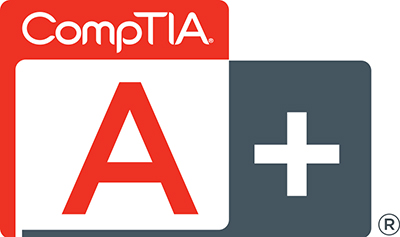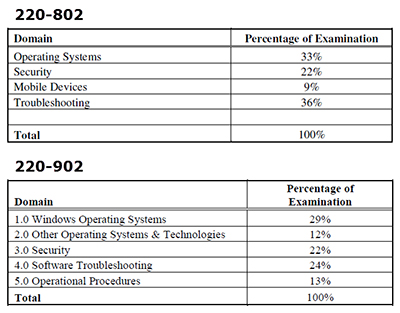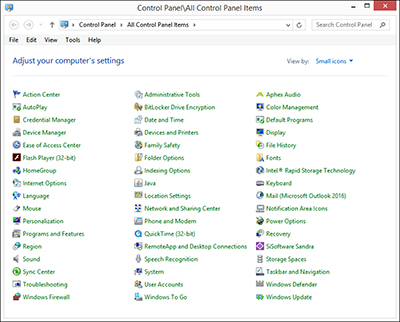In Part 1 of this two-part series, I described the CompTIA A+ 220-901 "hardware" exam, pointing out how it differs from its predecessor, 220-801. In this article, I'll discuss its counterpart 220-902 "software" test, beginning with a bird's-eye perspective of the two versions of the certification exam. You'll need to pass both exams to earn A+ certification (see Figure 1).

Figure 1 CompTIA A+ certification logo.
802 Versus 902: High-Level Differences
Start by downloading the CompTIA A+ 220-802 and 220-902 objective blueprints for comparison purposes. CompTIA clearly describes in those documents the skills required to pass the software exam.
In Figure 2, I extracted the top-level content domains from each exam. I'll share my observations with you after the figure.

Figure 2 Comparing the CompTIA A+ 220-802 and 220-902 exams.
The most obvious initial change is that CompTIA organized the 220-902 objectives across five domains instead of the previous four. The old "Mobile Devices" domain has been moved to the 220-901 blueprint, and CompTIA now splits operating-system support across Microsoft Windows and non-Windows lines. To pass your 220-902 test, you'll need to become a power user of the following desktop and mobile operating systems:
- Microsoft Windows (Windows Vista, Windows 7, and Windows 8.1)
- Linux (you'll be safest practicing with the Ubuntu or Debian distribution)
- Apple OS X
- Apple iOS
- Google Android
- Windows Phone
Finally, we see a new domain called "Operational Procedures" in the 220-902 blueprint. The A+ objectives have historically required candidates to know the standards and practices of computer hardware and software support in addition to customer-service skills. What CompTIA has done in the 902 exam is simply move those standards and practices into the 21st century.
Now let's drill down into each 220-902 content domain in more detail.
Domain 1.0: Windows Operating Systems
It's clear to me that CompTIA would have included coverage of Windows 10 if Microsoft had released the product in time. But alas, that's not to be. Instead, we're required to know how to install, configure, and troubleshoot computers running Windows Vista through Windows 8.1. Windows XP has officially reached the infamous "dead operating system" status.
Notice that we're not concerned specifically with Windows Server. CompTIA covers enterprise-level server content in its N10-006 Network+ exam.
My biggest tip for this part of the exam is to learn all the Windows Control Panel utilities inside and out. Figure 3 shows the Windows 8.1 Control Panel.

Figure 3 Know the Windows Control Panel inside and out.
Not only do you need to understand the Windows operating system per se, but you're also required to understand a bit about client-side virtualization. I'm talking about products like Hyper-V and VMware, which are desktop "hypervisors" that enable you to run a software-based virtual machine (VM) from within your hardware host.
While studying the 220-902 objectives, you'll find that CompTIA places heavy emphasis on client-side security options and configuration. Again, this is in keeping with CompTIA's attempt to make the A+ skill set as up-to-the-moment as possible. That's a good thing!
I'd strongly suggest that you build a practice lab and create VMs running all the relevant Windows versions. Believe it or not, you can do this for free! Simply download and install Oracle VirtualBox VM on your computer, and then create virtual machines using free Microsoft evaluation OS software. Awesome!
Domain 2.0: Other Operating Systems and Technologies
Apple OS X and Linux have established a big enough footprint in the consumer/prosumer space that CompTIA finally added coverage for these operating systems to the 220-902 objectives.
Linux is free, so you can build a Linux VM for your studying pleasure with no additional investment required. Getting hands-on experience with OS X may be more difficult, because you really need physical access to an Apple computer.
However, in scanning the 220-902 blueprint you'll see that CompTIA focuses primarily on command-line tools. The tools (commands like pwd, ps, grep, and so forth) are the same between Linux and OS X because the OS X kernel is based on UNIX.
In keeping with CompTIA's focus on 21st-century IT trends, you need to be familiar with basic cloud-computing concepts. Remember that CompTIA's exams are (at least on paper) vendor-neutral, so your study of cloud services should be general and not specific to Microsoft Azure, Apple iCloud, Google Apps, Amazon Web Services, and the like.
CompTIA also rolled mobile operating systems into this objective domain. Once again you're faced with the challenge of attaining hands-on, practical experience with iOS, Android, and Windows Phone. One idea is to source old smartphones from local thrift shops or eBay. Another is to ask friends, family, and colleagues whether you can borrow an old device running one of those mobile operating systems.
Domain 3.0: Security
In the Security domain, you'll take your existing skills with desktop and mobile operating systems and apply them to specific security threats and vulnerabilities.
Remember that CompTIA offers Security+ credentials for anyone interested in qualifying as an IT security specialist. For the A+ credential, you're nonetheless required to understand the differences between worms, viruses, Trojans, and other malware nasties. More importantly, the 220-902 objectives also cover best practices for removing malware on desktop and mobile devices.
This domain also covers material that's normally found on higher-level IT security certifications like the CISSP. I'm talking about stuff like IT security policies, end-user awareness training, social engineering, and so forth.
Domain 4.0: Software Troubleshooting
In this domain, CompTIA provides A+ candidates with a large number of specific desktop and mobile OS software problems. Your job is to understand how to resolve those issues by applying the CompTIA six-step troubleshooting model and IT industry best practices.
The 220-901 troubleshooting domain required you to know how to wield hardware troubleshooting tools—stuff like POST cards, loopback plugs, and of course screwdrivers. By contrast, all the 220-902 troubleshooting tools are of the software variety. For this domain, focus on the diagnostic and repair utilities that ship with Windows, OS X, Linux, iOS, Android, and Windows Phone.
Domain 5.0: Operational Procedures
The Operational Procedures domain, which I've always referred to affectionately as the "Soft Skills" domain, is largely unchanged between 220-802 and 220-902. After all, ESD safety isn't exactly an ever-changing science. Likewise, we've had MSDS sheets, occupational safety procedures, and environment controls in the A+ body of knowledge since CompTIA initially launched the program in 1993.
Final Thoughts
I first earned my A+ in 1999, so I've seen the exam evolve over the years. I'd like to leave you with two valuable pieces of advice: First, you earn your A+ only if you pass both exams. I've had students who felt short-changed that they received no CompTIA validation after investing the money, effort, and time required to pass either the hardware or software exam. It doesn't matter a bit whether you take the 901 or the 902 first; what counts is that you'll become A+ certified after you pass your second test.
Second, in my experience it doesn't matter which exam version you pass, or what your passing score is. I've never heard of a human resources interviewer or IT hiring manager asking either of the following questions of a job applicant:
- "Do you have the 800- or 900-series A+ certification?"
- "What were your exam scores?"
For the vast majority of IT certification exams, a pass is a pass, regardless of whether you just squeak by or you earn 100%. So don't stress too much over your score report.
With regard to the question of taking the 800 series vs. the 900 series exams, I'd say that if you're at least halfway to earning the 800-series A+, just continue your work. Be sure to pass your second exam before CompTIA retires the 800-series A+ English exam on June 30, 2016.
On the other hand, if you're at the beginning of your learning curve, I strongly suggest working with the latest-and-greatest 900 series A+ objectives, if for no other reason than that you'll be studying up-to-the-moment technology and industry trends.
In either case, good luck on your IT certification journey!

